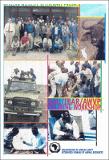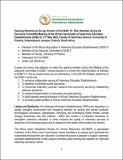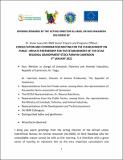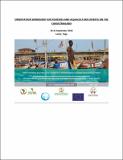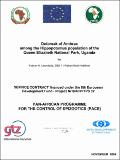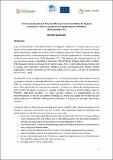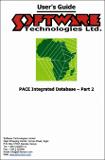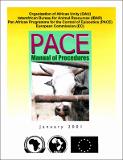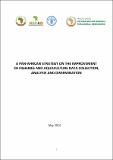Browsing AU-IBAR Initiatives and Project Reports by Title
Now showing items 256-275 of 452
-
OAU-IBAR AWVP TRAINING WORKSHOP held at Kenya Wildlife Service Veterinary Unit, Langata, Nairobi Kenya
The AWVP is a component of PARC, a well-established veterinary programme. It aims at eradicating rinderpest virus from Africa. The project will establish systems to monitor rinderpest at the interface between wild and ... -
OAU-IBAR farming in tsetse control areas programme (FITCA)mid-term review..PDF
This study is the mid term review of the FITCA (Farming in tsetse controlled areas) Programme. This review is commissioned as planned in the FITCA Financing agreement. It has however been slightly delayed to take into ... -
OBSERVATIONS ON PACE TANZANIA EXTENSION WORK PLAN AND COST ESTIMATES FOR YEAR 1 SUBMISSION OF EXTENSION GLOBAL PLAN.
This document presents a global plan for the proposed two years extension of the Tanzania component of the Pan-African Programme for the Control of Epizootics (PACE-TZ). PACE-TZ, together with 28 other African country ... -
Opening Remarks by the Ag. Director of AU-IBAR, Dr. Nick Nwankpa during the Executive Committee Meeting of the African Association of Veterinary Education Establishments (2A2E-V), 31st May 2022, Faculty of Veterinary Science, University of Pretoria, Onderstepoort campus, Pretoria, South Africa
(2022-05-31)Opening Remarks by the Ag. Director of AU-IBAR, Dr. Nick Nwankpa during the Executive Committee Meeting of the African Association of Veterinary Education Establishments (2A2E-V), 31st May 2022, Faculty of Veterinary ... -
Opening Remarks by the Director of AU-IBAR ECOWAS Annual Regional Animal Health Networks (RAHN)
(2022)Opening Remarks by the Director of AU-IBAR, Dr. Nick Nwankpa, during the ECOWAS Annual Regional Animal Health Networks (RAHN), held in Cape Verde from 19-23 September, 2022 -
Opening Remarks from AU-IBAR during Consultation and coordination meeting for the establishment on Public –Private Partnership for the establishment of the ECCAS Regional grandparent stock farm in Cameroon 5th January 2022
(2022-01)Opening remarks made by Dr. Anne Lewa on behalf of AU-IBAR Director, Dr. Nick Nwankpa during Consultation and coordination meeting for the establishment on Public –Private Partnership for the establishment of the ECCAS ... -
Opening Remarks of Dr. Nick Nwankpa, Director Of AU-IBAR at the 5th Africa Animal Welfare Conference-Action 2021
(2021-11-01)Opening Remarks of Dr. Nick Nwankpa, Director Of AU-IBAR at the 5th Africa Animal Welfare Conference-Action 2021 held in Accra, Ghana on 1st November, 2021. -
Organisation of African Unity / Inter African Bureau for Animal Resources (OAU/IBAR) Farming In Tsetse Controlled Areas (FITCA - Kenya Project).
This report is based on the findings of a survey carried out for FITCA-K by Kamau Kabbucho of Fineline Systems & Management Limited. The survey was commissioned to identify strategies and mechanisms by which FITCA-K could ... -
Orientation workshop for fisheries and aquaculture experts on the CAADP/MALABO
(2016-09)Report on the orientation workshop for fisheries and aquaculture experts on the CAADP/MALABO held from 19-21 September 2016, in Lome, Togo -
Outbreak of Anthrax among the Hippopotamus population of the Queen Elizabeth National Park, Uganda.pdf
A severe epidemic affecting hippopotami was reported in Queen Elizabeth National Park (QENP), Uganda. At least 215 individuals had died of an acute infection with B. anthracis, which is known to be lethal for hippopotami. ... -
Outcomes Report: 3rd General Assembly and Bi-Annual Meeting of the Africa Platform for Regional Institutions in Fisheries, Aquaculture & Aquatic Systems (APRIFAAS) 28-29 September 2021
(2021-09-29)The outcomes report provides an overview of the deliberations and procedures of the 3rd General Assembly and Bi-Annual Meeting of the Africa Platform for Regional Institutions in Fisheries, Aquaculture & Aquatic Systems ... -
PACE (K) 1sT QUARTER REPORT
Pan African Rinderpest Campaign (PARC) Kenya project was implemented alongside Emergency Programme for the Eradication of Rinderpest in Kenya (EPERK). The components addressed under PARC (K) project were: (i) Rinderpest ... -
PACE FIRST HALF YEARLY REPORT JUNE-NOVEMBER 2002 YEAR THREE WORK PLAN AND COST ESTIMATE December 2002
The report summarizes the activities of the PACE Coordination Unit (PCU) and its Common Services during the first half year of the third work plan of PACE. It focuses on monitoring of national PACE programmes and support ... -
PACE FIRST HALF YEARLY REPORT JUNE-NOVEMBER 2002 YEAR THREE WORK PLAN AND COST ESTIMATE December 2002
The report summarizes the activities of the PACE Coordination Unit (PCU) and its Common Services during the first half year of the third work plan of PACE. It focuses on monitoring of national PACE programmes and support ... -
PACE Integrated Database Part 2
Passive Surveillance is a method whereby data on animal disease occurrence is collected from livestock owners' reports and field observation During this type of surveillance, the Vet in charge does not actively go into the ... -
PACE Kenya project first quarter progress report for year 2 annual work programme.
The second year workplan was approved in December, 2002. Despite the holiday season and national elections, project activities still continued during the quarter. Follow-up investigations of the suspected Laikipia rinderpest ... -
PACE Manual Procedures.
Animal health is a prior condition for the development of livestock farming and the rural world in Africa where, despite meat imports in particular, the population does not get proper amounts of animal protein. Animal ... -
Pan - African programme for the control of Epizootic diseases (PACE) mid-term review.
The report presents the findings of the mid-term review (MTR) of PACE, the Pan African Program for the Control of Epizootic Diseases. The MTR was undertaken in October-November of 2002 by a team assembled by Development Network-of ... -
A Pan - African Strategy on the Improvement of Fisheries & Aquaculture data collection, Analysis & dissemination
(2014-05)This strategic document is intended to provide a framework and guidelines that should lead to improvements in the availability and quality of national and regional data to support fisheries management, aquaculture ... -
PAN AFRICAN PROGRAMME FOR THE CONTROL OF EPIZOOTIC DISEASES (PACE) MID-TERM REVIEW AGREEMENT NO 6125
The PACE programme is a major development programme financed by the EDF in the field of animal health in Africa, reaching 32 African countries. The Programme started on November lst, 1999, and countries started the ...
